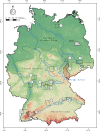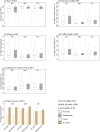Large-scale investigations of Neolithic settlement dynamics in Central Germany based on machine learning analysis: A case study from the Weiße Elster river catchment
- PMID: 35442952
- PMCID: PMC9020700
- DOI: 10.1371/journal.pone.0265835
Large-scale investigations of Neolithic settlement dynamics in Central Germany based on machine learning analysis: A case study from the Weiße Elster river catchment
Abstract
The paper investigates potentials and challenges during the interpretation of prehistoric settlement dynamics based on large archaeological datasets. Exemplarily, this is carried out using a database of 1365 Neolithic sites in the Weiße Elster river catchment in Central Germany located between the southernmost part of the Northern German Plain and the Central Uplands. The recorded sites are systematically pre-processed with regard to their chronology, functional interpretation and spatial delineation. The quality of the dataset is reviewed by analyzing site distributions with respect to field surveys and modern land use. The Random Forests machine learning algorithm is used to examine the impact of terrain covariates on the depth of sites and pottery preservation. Neolithic settlement dynamics are studied using Site Exploitation Territories, and site frequencies per century are used to compare the intensity of land use with adjacent landscapes. The results show that the main trends of the Neolithic settlement dynamics can be derived from the dataset. However, Random Forests analyses indicate poor pottery preservation in the Central Uplands and a superimposition of Neolithic sites in the southernmost part of the Northern German Plain. Throughout the Neolithic the margins between soils on loess and the Weiße Elster floodplain were continuously settled, whereas only Early and Late Neolithic land use also extended into the Central Uplands. These settlement patterns are reflected in the results of the Site Exploitation Territories analyses and explained with environmental economic factors. Similar with adjacent landscapes the Middle Neolithic site frequency is lower compared to earlier and later periods.
Conflict of interest statement
The authors have declared that no competing interests exist.
Figures










Similar articles
-
Overbank silt-clay deposition and intensive Neolithic land use in a Central European catchment - Coupled or decoupled?Sci Total Environ. 2022 Feb 1;806(Pt 4):150858. doi: 10.1016/j.scitotenv.2021.150858. Epub 2021 Oct 8. Sci Total Environ. 2022. PMID: 34627920
-
Hydro-sedimentary provenance analyses in the Weiße Elster catchment (Central Germany): The basic dataset.Data Brief. 2021 Dec 16;40:107719. doi: 10.1016/j.dib.2021.107719. eCollection 2022 Feb. Data Brief. 2021. PMID: 34993286 Free PMC article.
-
Pottery spilled the beans: Patterns in the processing and consumption of dietary lipids in Central Germany from the Early Neolithic to the Bronze Age.PLoS One. 2024 May 16;19(5):e0301278. doi: 10.1371/journal.pone.0301278. eCollection 2024. PLoS One. 2024. PMID: 38753872 Free PMC article.
-
Take a seed! Revealing Neolithic landscape and agricultural development in the Carpathian Basin through multivariate statistics and environmental modelling.PLoS One. 2021 Oct 29;16(10):e0258206. doi: 10.1371/journal.pone.0258206. eCollection 2021. PLoS One. 2021. PMID: 34714837 Free PMC article.
-
Geochemical signatures (C, N, delta13C, delta15N, metals) of suspended matter in the river Weisse Elster (central Germany): their seasonal and flow-related distribution 1997-2001.Isotopes Environ Health Stud. 2005 Jun;41(2):141-59. doi: 10.1080/10256010500131874. Isotopes Environ Health Stud. 2005. PMID: 16191766
References
-
- Cendrero A, Remondo J, Bonachea J, Rivas V, Soto J. Sensitivity of landscape evolution and geomorphic processes to direct and indirect human influence. Geografia Fisica e Dinamica Quaternaria. 2006; 29:125–137.
-
- Dotterweich M. The history of soil erosion and fluvial deposits in small catchments of central Europe: Deciphering the long-term interaction between humans and the environment—a review. Geomorphology. 2008; 101:192–208. 10.1016/j.geomorph.2008.05.023 - DOI
-
- Brown AG, Tooth S, Bullard JE, Thomas DSG, Chiverell RC, Plater AJ, et al.. The geomorphology of the Anthropocene: emergence, status and implications. Earth Surf Process Landf. 2017; 42:71–90. 10.1002/esp.3943 - DOI
-
- Menges J, Hovius N, Andermann C, Dietze M, Sowboda C, Cook CL, et al.. 2019. Late Holocene landscape collapse of a trans-Himalayan dryland: Human impact and aridification. Geophys Res Lett. 2019; 46:13814–13824. 10.1029/2019GL084192 - DOI
-
- Litt T, Schölzel C, Kühl N, Brauer A. Vegetation and climate history in the Westeifel Volcanic Field (Germany) during the past 11 000 years based on annually laminated lacustrine maar sediments. Boreas. 2009; 38:679–690. 10.1111/j.1502-3885.2009.00096.x - DOI
Publication types
MeSH terms
Substances
LinkOut - more resources
Full Text Sources

